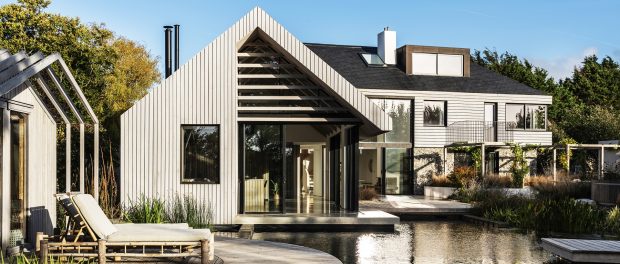Biophilic building design and how it impacts our physical and psychological health
With a growing number of people spending the vast majority of their time indoors, there is a wealth of evidence to suggest that creating strong connections between nature and man-made environments can increase our wellbeing. Here, Dr Ed Suttie, research director, BRE, considers how biophilic building design can positively influence our physical and psychological health.
We know the health benefits of exercise and a balanced diet, but what of our buildings – the environment we spend 90% of our lives in? We isolate ourselves from nature at home, at work and in daily life – and evidence abounds that this is to our detriment.
Breaking through the visual beauty of buildings and the ephemera that we surround ourselves with, there is a deep complexity to health, wellbeing and buildings. Comfort, mind and aesthetics hint at the hidden depths of how we perceive and experience materials, spaces and buildings – colour, light, humidity, texture, surfaces. We explore further – what materials are around us? Why do we get a headache working in that environment? Why are we calm in this space? Why are we hot when our co-workers feel cold? It is complex and some of it is personal to us as individuals.
Whole building certification schemes such as BREEAM have always had a section on health and wellbeing in them. However, it was the WELL Building Standard, Fitwel, Portico and others that, in the last two years, have disrupted the market. They focussed attention on the health and wellbeing of building occupants and, in the case of offices, the spinoff of improved collaboration, cooperation, communication and productivity. These certification schemes raised questions never asked of construction and refurbishment projects. The World Green Building Council rightly pointed out that staff and their benefits are responsible for 90% of costs for an office-based company and it seems wise to pay attention to the people as a source for business improvement.
Highly urbanised
In terms of human evolution, our species has spent a tiny fraction of time in the built environment. Our physiological functions are adapted to nature, yet we exist almost entirely in highly urbanised and artificial settings. It is no surprise, therefore, that the impact our buildings have on how we work, heal, learn and rest is highly significant. From our health and wellbeing to our livelihoods and the economy, the natural world has a part to play and the construction sector is no exception. Biophilic design offers an inspiring umbrella, under which many health and wellbeing features that impact on workplace environments can be captured.
Harvard professor Edward O Wilson’s book, ‘Biophilia’, concluded we have a genetic connection to nature and hold a biological need for physical, mental and social connections with it. Research has shown that being in natural environments – even viewing scenes of nature – has a positive impact on our wellbeing. Presence in natural environments can alleviate negative emotions such as anger, anxiety, depression and stress, while helping us to restore, feel calm and be inspired. The health and wellbeing benefits for building occupants and the promotion of the connection to nature can be achieved by implementing biophilic design. This was articulated by Stephen Kellert in the early 1990s and latterly Terrapin Bright Green have pioneered the 14 patterns of biophilic design which are deployed internationally across healthcare, education, public and office buildings.
The scientific evidence for the positive influence of biophilic design on the health and wellbeing of building occupants is growing. In an office environment this is shown as quantified improvements in business outcomes, staff retention and a reduction in days absent due to illness. More than 130 million days are lost to sickness absence every year in Great Britain and working-age ill health costs the national economy £100 billion a year. A 1% reduction in absenteeism would convert to a saving, in lost days alone, of £1 billion to the economy. Building owners and facilities managers need to know what they can do within limited budgets to create restorative and occupant health driven environments.
Leading international HQ offices in the UK are creating restorative and occupant health driven environments almost instinctively – maximising natural light, striving for clean air etc. as well as considering the business case. These projects are stirring the conversations and grabbing headlines, which is fantastic. To enable the conversation at the other end of the marketplace, building owners and facility managers need to know what they can do within limited budgets and the predicted return on investment. Evidence is lacking, which was a key motivation for the BRE biophilic office project.
The Biophilic Office
The BRE and Oliver Heath Design (leading exponent of biophilic design), supported by industry partners Biotecture (green walls), AkzoNobel (colour), Interface (flooring), Ecophon (acoustics), Ambius (plants), Waldmann (light), Ahrend (furniture), GVA (economics) Plantronics (noise cancellation) and Coelux (skylights), have started a research project to deepen the evidence base for biophilic design and its positive impact on office occupants. This will help realise the exciting untapped potential in our existing buildings. A live office refurbishment on the BRE Watford campus is providing robust indoor environment and occupant data. In order to create a baseline, the impact of factors in the existing building, such as acoustics, light, air quality and thermal comfort on its occupants will be monitored, before a ‘biophilic’ refurbishment takes place. This will be followed by the monitoring of the office space and its occupants again, post-refurbishment, for another year.
The long-term findings are intended to link to the biophilic refurbishment strategies deployed, giving a better understanding of the influence of product and design on occupants. As well as the project providing open guidance with the assistance of professional institutions, we expect certification schemes such as BREEAM will utilise the findings where possible. Refurbishment doesn’t have to be deep and expensive – the choice of floor covering, wall paint and lighting have significant biophilic qualities and as such, informed choices, guided by research evidence, can help create positive, healthier and more energising workplaces of the future, from the offices of the past.




















